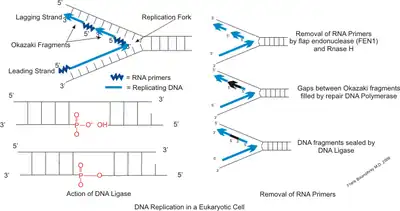
A primer binding site is a region of a nucleotide sequence where an RNA or DNA single-stranded primer binds to start replication. The primer binding site is on one of the two complementary strands of a double-stranded nucleotide polymer, in the strand which is to be copied, or is within a single-stranded nucleotide polymer sequence.[2]
DNA Replication
.jpg.webp)
DNA replication is the semi-conservative, biological process of two DNA strands copying themselves, resulting in two identical copies of DNA.[4][5] This process is considered semi-conservative because, after replication, each copy of DNA contains a strand from the original DNA molecule and a strand from the newly-synthesized DNA molecule.[5]
An RNA primer is a short chain of single-stranded RNA, consisting of roughly five to ten nucleotides complementary to the DNA template strand. DNA polymerase will then take each nucleotide and make a new complementary DNA strand to the template strand, but only in the 5' to 3' direction. One of the new strands, the leading strand, moves in the 5' to 3' direction until it reaches the replication fork, allowing DNA polymerase to take the RNA primer and make a new complementary DNA strand to the template strand. The lagging strand moves away from the replication fork in the 3' to 5' direction and consists of small fragments called Okazaki fragments. DNA polymerase makes the lagging strand by using a new RNA primer for each Okazaki fragment it encounters. Overall, the leading strand only uses one RNA primer, while the lagging strand uses a new RNA primer for each Okazaki fragment it comes across.[6]
Polymerase Chain Reaction (PCR)
Polymerase chain reaction (PCR) is a method used in laboratories that significantly increases the production of replicated DNA sequences. PCR has revolutionized science by allowing laboratories to replicate up to billions of DNA sequences in only a few hours.[7] This method has been used to diagnose diseases, sequence and clone genes, detect pathogens, and locate criminals. PCR has even allowed the Human Genome Project to advance immensely.[8]
A PCR primer is a short chain of single-stranded DNA, consisting of roughly twenty nucleotides complementary to the target sequence of DNA. During PCR, two primers will bind to opposite template strands of DNA. The two primers point towards one another, allowing only a specific region of DNA to be copied.[9] Scientists use PCR primers to analyze a targeted section of DNA.[10]

References
- ↑ Boumphreyfr (2009-06-23), עברית: רפליקציית DNA בתא אאוקריוטי, תוך שימוש בתחל., retrieved 2021-11-05
- ↑ Berg, Jeremy M.; Tymoczko, John L. & Stryer, Lubert. (c. 2002). "DNA Replication of Both Strands Proceeds Rapidly from Specific Start Sites". Biochemistry. New York: W. H. Freeman and Co.
- ↑ Programme, Genomics Education (2014-03-11), This image was created by the NHS National Genetics and Genomics Education Centre. For further information and resources please visit our website www.geneticseducation.nhs.uk, retrieved 2021-11-05
- ↑ "3.5 Nucleic Acids - Biology 2e | OpenStax". openstax.org. Retrieved 2021-11-05.
- 1 2 Miller, Christine (2020-09-01). "5.4 DNA Replication".
{{cite journal}}: Cite journal requires|journal=(help) - ↑ "Molecular mechanism of DNA replication (article)". Khan Academy. Retrieved 2021-11-29.
- ↑ "Polymerase Chain Reaction (PCR)". Genome.gov. Retrieved 2021-11-05.
- ↑ Garibyan, Lilit; Avashia, Nidhi (March 2013). "Research Techniques Made Simple: Polymerase Chain Reaction (PCR)". The Journal of Investigative Dermatology. 133 (3): 1–4. doi:10.1038/jid.2013.1. ISSN 0022-202X. PMC 4102308. PMID 23399825.
- ↑ "Polymerase chain reaction (PCR) (article)". Khan Academy. Retrieved 2021-11-30.
- ↑ "Primer". Genome.gov. Retrieved 2021-11-30.
- ↑ Madonini, Fabio (2016-06-29), Italiano: Schema dei primer per la PCR: il prodotto dell'amplificazione al termine del programma è il segmento di DNA compreso tra il primer forward e il primer reverse, retrieved 2021-11-30
External links